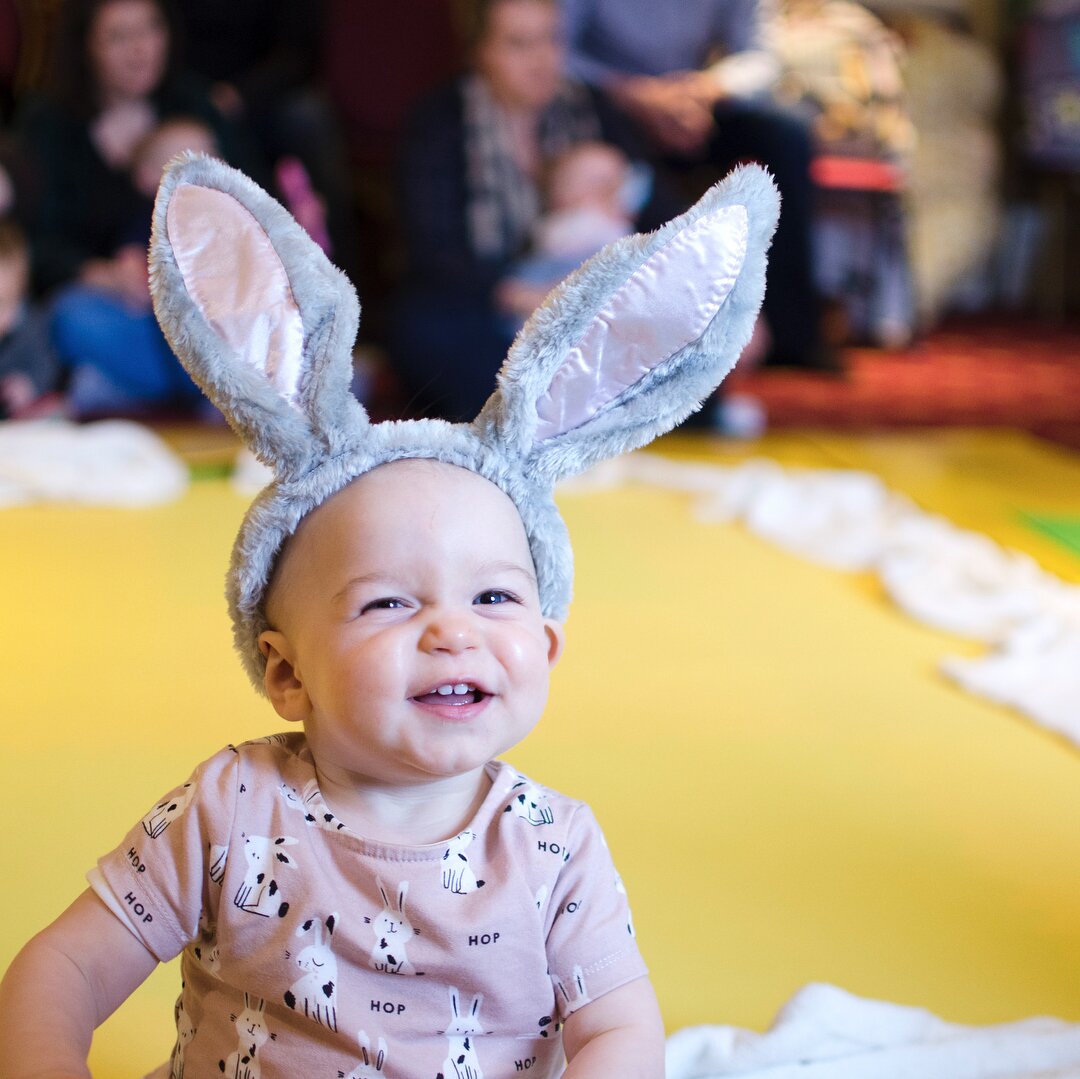Your baby may be too young to decorate a hard-boiled egg or go on an egg hunt, but there are still plenty of ways to make Easter an educational and enjoyable event.
Here are a few ideas to get you started:

Hide and seek
One of the best games to play with your baby is ‘peek-a-boo’ or ‘hide-and-seek’. It’s traditional, simple to organise, educational, and lots of fun.
A rabbit puppet and a pop-up frog are wonderful hide and seek toys. They provide a wealth of learning opportunities from visual stimulation to speech and language development. They also encourage rich parent-baby interactions and the element of surprise that babies love so much.
To develop your baby’s thinking, memory and hand-eye coordination skills, hide a plastic egg under a cloth or cup. Say “Where’s the egg?” If your baby is at the reaching and grasping stage, she will look for it, even though it is out of sight. From the age of nine months, your baby may deliberately prolong the fun by hiding the object for you to discover.
If you have a spare tissue box, fill it with brightly coloured fabrics. Your baby will delight in pulling out the materials one by one. She will also discover that when you put the materials back in the box, they continue to exist even though they are hidden from view.
To encourage logical thinking, problem-solving and exploratory skills, hide behind the sofa and call your baby’s name. When your baby discovers your hiding place, she will learn that you haven’t just vanished because you are out of sight. This teaches your baby about object permanence and stability. Psychologist Jean Piaget suggested that this awareness was typically achieved at about six months of age. However, studies show that if peek-a-boo games are played regularly, babies understand these concepts from about two months of age.
Easter books
Three-dimensional books with large, brightly coloured illustrations, textured materials and hide-and-seek pictures that encourage interaction make great Easter presents for babies. Your baby may investigate the properties of a texture with her finger tips or turn the pages to discover something new. Your voice and facial expressions will capture your baby’s interest and attention and liven up her experience of the world. Best of all, your baby will enjoy cuddling up to you, which has a huge impact on her future learning and development. Research shows that babies who are regularly cuddled have bigger brains than babies who are deprived of close loving physical contact.
Easter treasure basket
Line a shallow basket with a soft bunny blanket and fill it up with Easter-themed objects such as a plastic egg, a textured book, a soft toy rabbit, lamb or duck and a mealtime set. Include a toy that your baby can safely chew on.
When your baby can sit up with or without support, a treasure basket filled with safe, interesting and engaging objects will develop her sense of curiosity. When your baby explores the objects, she will find out about weight, size, shape, taste, smell, sound and temperature. Every time a new object is explored, highly sensitive nerve endings in the skin will send messages to her brain. In this way, information is collected that will lead to the later recognition of objects.
Easter songs
Focus on Easter songs such as ‘Peter Rabbit’ and ‘5 little Ducks’. Even if your baby cannot understand the words, she will enjoy the sound of your voice and your facial gestures and body movements. These time-honoured songs have a repetitive theme, which help to establish a sense of order (mathematical reasoning) and a sense of security. They also provide a powerful stimulus in terms of language and social development.
Easter games
A simple activity such as rolling a plastic egg across the floor will encourage a whole range of mobility skills as well as hand-eye coordination and sensory exploration. When your baby is a little older, you can sit on the floor and roll the egg back and forth or roll it down a slope for your baby to catch. An egg that makes playful sounds will provide an endless source of amusement and fun. Best of all, your quality interactions will make a huge difference to your baby’s emotional development and learning.
Nesting eggs
Towards the end of the first year, your baby will enjoy activities that encourage use of the pincer grip. A multi-coloured nesting egg set for example, provides a wonderful, educational opportunity. When your baby tries to nest the eggs, she will learn about size and space, which forms the foundation for mathematical and spatial awareness. These skills will stand her in good stead for the future.
Easter outing
The spring air provides the perfect opportunity to tantalise your baby’s sense of smell. The fragrance of flowers, cut grass, new leaves growing and the smell of rain will help your baby learn about the world. Fresh air contains high levels of negative ions that can have a positive impact on your baby’s health and brain function. Sunlight provides Vitamin D that your baby needs to grow strong, healthy bones and offers protection from a number of common ailments and disorders.
Activities that the whole family can enjoy together might include a visit to the river or pond to see the ducklings, a trip to a farm to see the baby animals or the excitement of an Easter party, which includes relatives and close friends. Avoid dressing up as the ‘Easter Bunny’ since the costume might unsettle or even frighten your baby.
Capture the occasion
To mark the occasion, dress your baby in an Easter-themed outfit. Your baby will look adorable in a bunny costume. Capture the moment on camera. A photograph will provide a fond memory of your baby’s first Easter for many years to come.
